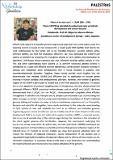Por favor, use este identificador para citar o enlazar a este item:
http://hdl.handle.net/10261/210344COMPARTIR / EXPORTAR:
 SHARE
BASE SHARE
BASE
|
|
| Visualizar otros formatos: MARC | Dublin Core | RDF | ORE | MODS | METS | DIDL | DATACITE | |

| Título: | CRISPRing zebrafish to understand early vertebrate development and human diseases |
Autor: | Moreno-Mateos, Miguel A. CSIC ORCID | Fecha de publicación: | 12-abr-2019 | Citación: | XIX Workshop de Genética UNESP/BOTUCATU (2019) | Resumen: | CRISPR-Cas9 system is a powerful genome engineering approach that is now widely used. This targeting system is based on two components: a single guide RNA (sgRNA) that directs the Cas9 endonuclease to the target site to be mutated However, variable activity across different sgRNAs can limit the mutagenic efficiency. We have optimized the CRISPR-Cas9 system in zebrafish by analyzing the mutagenic activity of 1920 sgRNAs and developing an algorithm, CRISPRscan (www.crisprscan.org) that efficiently predicts sgRNA activity in vivo. This and other optimizations have allowed us to perform functional genetic screens in vertebrates in a rapid and efficient manner identifying a novel protein complex involved in splicing and vertebrate brain development that is found mutated in patients with neurodevelopmental disorders. Together, these results provide novel insights into the determinants that mediate CRISPR-Cas9 efficiency and its application to uncover genes involved in human diseases and developmental disorders. However, the number of genomic targets of the CRISPR-Cas9 system is limited due to the PAM sequence restriction. To extend the in vivo repertoire of potential targeting sites in the genome, we have characterized and optimized different CRISPR associated endonucleases such as AsCpf1 and LbCpf1. We have demonstrated that i) LbCpf1, but not AsCpf1, ribonucleoprotein complexes allow efficient mutagenesis in zebrafish and Xenopus and ii) temperature modulates Cpf1 activity being this effect stronger on AsCpf1 which provides post-translational modulation of AsCpf1-mediated genome editing and explains its lower activity in ectothermic organisms such as Drosophila, Xenopus and zebrafish. All together, these results contribute to the molecular understanding of Cpf1 activity in vivo and establish this tool as an efficient and inducible genome engineering system across ectothermic species. Finally, one of the main interests in the early development field is to study the maternal-to-zygotic transition (MZT), a universal process that occurs in all animals. One of the critical stages during this transition is the activation of the silent zygotic genome after fertilization. However, the mechanisms underlying this process are poorly understood. To address this, we have optimized a CRISPR-Cas9-based live imaging approach of transcription in zebrafish and show that genome activation begins at the miR-430 locus. In contrast to current models, we show that genome activation does not require the titration of maternal repressors, occurs independent of cell division and is regulated through both translation of maternal mRNAs and the effects of these factors on the chromatin acetylation. In summary, these results open a new dimension into understanding the maternal factors and mechanisms that enable activation of the genome | Descripción: | Resumen del trabajo presentado en el XIX Workshop de Genética UNESP/BOTUCATU, celebrado en Botucatu (Brasil), del 12 al 14 de abril de 2019 | URI: | http://hdl.handle.net/10261/210344 |
| Aparece en las colecciones: | (CABD) Comunicaciones congresos |
Ficheros en este ítem:
| Fichero | Descripción | Tamaño | Formato | |
|---|---|---|---|---|
| CRISPRing zebrafish.pdf | 152,23 kB | Adobe PDF |  Visualizar/Abrir |
CORE Recommender
Page view(s)
131
checked on 23-abr-2024
Download(s)
70
checked on 23-abr-2024
Google ScholarTM
Check
NOTA: Los ítems de Digital.CSIC están protegidos por copyright, con todos los derechos reservados, a menos que se indique lo contrario.
